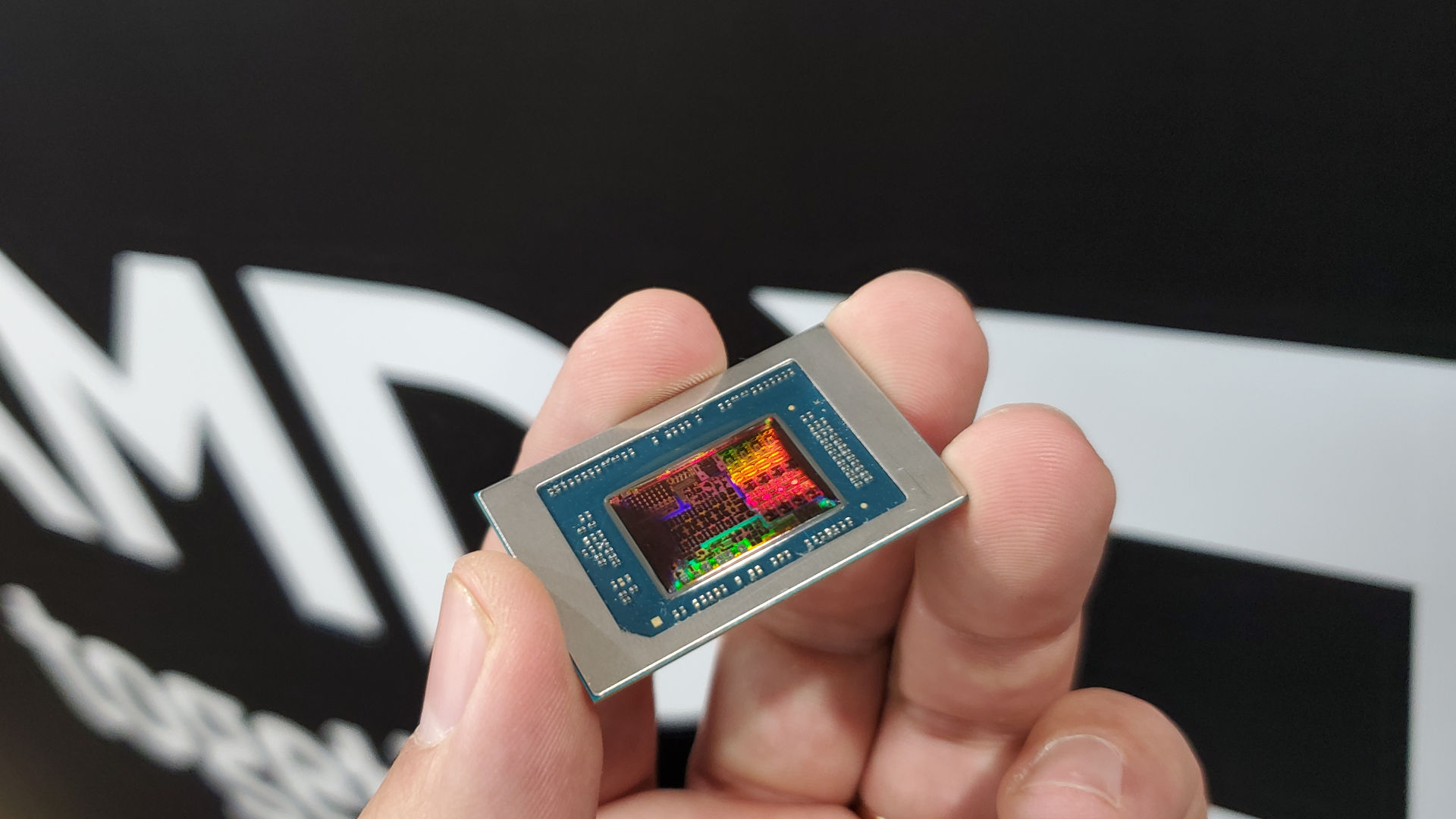Nvidia and Intel joining forces could be seen as anti-AMD, but it just serves to highlight AMD’s advantage with Ryzen and Radeon under one roof
By Jacob Ridley
Copyright pcgamer

Skip to main content
Close main menu
THE GLOBAL AUTHORITY ON PC GAMES
View Profile
Search PC Gamer
PC Gaming Show
Movies & TV
Affiliate links
Meet the team
Community guidelines
About PC Gamer
PC Gamer Magazine Subscription
Why subscribe?
Subscribe to the world’s #1 PC gaming mag
Try a single issue or save on a subscription
Issues delivered straight to your door or device
From£35.99Subscribe now
Borderlands 4
Essential Hardware
Battlefield 6
Don’t miss these
Gaming Laptops
Best graphics card for laptops in 2025: the mobile GPUs I’d want in my next gaming laptop
Best CPU for gaming in 2025: These are the chips I recommend for gaming, productivity, and peace of mind
Best mini PCs in 2025: The compact computers I love the most
Graphics Cards
Best graphics cards in 2025: I’ve tested pretty much every AMD and Nvidia GPU of the past 20 years and these are today’s top cards
Intel and Nvidia announce stunning plans to combine their CPU and GPU products for both consumer PCs and AI servers, with Nvidia taking a $5 billion stake in Intel
It’s not just Nvidia that’s looking to cash in on those loosening US/China chip export restrictions, as AMD also seems close to resuming AI GPU shipments
Graphics Cards
AMD CEO Dr. Lisa Su says she can see AI ‘helping us design the next-generation GPU much faster and more reliably’
Trump praises Nvidia CEO Jensen Huang at AI summit, calling him a ‘great guy’, claiming he has 100% market share and his company is impossible to catch up to even if it had 10 terrible years. AMD CEO Dr. Lisa Su also in attendance
Move over, GPUs and CPUs: AMD is looking into creating AI accelerator cards to improve the neural performance of ordinary PCs
‘We’re going to build revolutionary products’ says Nvidia CEO Jensen Huang about his newly-announced collaboration with Intel: ‘Nothing of its kind has ever been built before’
Further details of Nvidia’s GB10 ‘superchip’ shine light on the complex collaboration with MediaTek
If you’re wondering what those newly announced Intel-Nvidia PC chips might look like, there’s already an Nvidia ‘Superchip’ that could provide the answers
Graphics Cards
AMD reckons its next-gen GPUs will beat Nvidia at ‘any sort of AI workload’ and we’re praying that rubs off on the company’s gaming graphics cards
Graphics Cards
AMD says its next-gen FSR ‘Redstone’ AI upscaling tech can run on Nvidia GPUs
OpenAI has teamed up with Broadcom to make its own AI processors, according to a report, possibly as part of a long-term plan to move away from Nvidia’s GPUs
Nvidia and Intel joining forces could be seen as anti-AMD, but it just serves to highlight AMD’s advantage with Ryzen and Radeon under one roof
Jacob Ridley
19 September 2025
A big benefit when it comes to AI.
When you purchase through links on our site, we may earn an affiliate commission. Here’s how it works.
(Image credit: AMD)
You’ve likely heard the news by now: Intel and Nvidia have agreed to build a new range of products together. These co-developed chips will fuse Intel’s x86 architecture with Nvidia’s RTX graphics chiplets. The idea being, if you bring together both companies’ tech, it’s possible to deliver something more flexible, more desirable than either company can deliver on its own.
The benefits for the two companies are clear enough. Nvidia needs processors for GPU-accelerated server racks, and despite its best efforts to buy Arm, that fell through, dashing any hope of becoming a fully-integrated hardware company with it. Intel needs a helping hand in a few ways. The company is struggling with a falling share price and recently struck a deal with the US government to buy a share of the business, and getting an in with one of the richest companies on the planet isn’t a bad get. Though supercharging its processors with more capable and powerful graphics chips has a few big benefits, too. To some degree in gaming, sure, but mostly AI.
“I think these are going to be revolutionary products. I know that all of us working on it are super excited about it,” Nvidia CEO Jensen Huang said in a joint conference with Intel CEO Lip-Bu Tan.
Related Articles
Intel and Nvidia announce stunning plans to combine their CPU and GPU products for both consumer PCs and AI servers, with Nvidia taking a $5 billion stake in Intel
It’s not just Nvidia that’s looking to cash in on those loosening US/China chip export restrictions, as AMD also seems close to resuming AI GPU shipments
AMD CEO Dr. Lisa Su says she can see AI ‘helping us design the next-generation GPU much faster and more reliably’
“Nothing of its kind has ever been built before.”
You might have something to say about that last statement if you work for AMD. The company is able to deliver competitive products across both CPU and GPU in-house. That’s been embedded into its DNA since it bought ATI, and only improved on and amplified since with the growing success of its Zen architecture (with admittedly a few ups and downs in between—a story for another time), and delivered many generations of APU. If anyone has shown the capability to consistently deliver a combination of high-performance processors and graphics in a single chip or system-on-chip (SOC), it’s AMD.
AMD is dominant in games consoles, through its semi-custom division and partnerships with Microsoft and Sony, for precisely this reason. It’s been highly successful here, scoring these console manufacturers as repeat clients for multiple generations, and according to current expectations for at another generation to come. In the PC space, we have products such as the newly-released Ryzen AI Max 300 Series to point to, a processor line-up we’ve tested multiple times in various forms this year.
(Image credit: AMD)
You might then consider this move from Intel and Nvidia to be pretty anti-AMD. I’m sure Dr. Lisa Su and other AMD executives have had a few emergency meetings to discuss yesterday’s announcement—which saw AMD’s share price dip sharply and then largely recover. Though there’s definitely a positive way of framing it for the red team:
The biggest gaming news, reviews and hardware deals
Keep up to date with the most important stories and the best deals, as picked by the PC Gamer team.
Contact me with news and offers from other Future brandsReceive email from us on behalf of our trusted partners or sponsorsBy submitting your information you agree to the Terms & Conditions and Privacy Policy and are aged 16 or over.
It just goes to show how much of an advantage AMD has if it plays its cards right.
No matter the promise of integration between Intel and Nvidia, no two competing companies will ever be able to collaborate quite as well as multiple departments within the same company. The sharing of GPU IP, if any such sharing occurs, between Intel and Nvidia would have to be pretty tight to keep either party out of the other’s biggest secrets, especially as both companies sort of dabble in similar sectors (Nvidia with Arm partnerships, Intel with Arc GPUs).
AMD’s advantage also extends deep into the technological stack. Let’s take Intel’s Foveros technology, for example. This is a way of lashing chiplets (tiles, in Intel speak) together onto a single interposer to operate as a single chip. We’ve seen this in action with various mobile architectures, Meteor Lake and Lunar Lake, but also since come into play with desktop chips. It’s also the key to these future x86 RTX SOCs.
Related Articles
Intel and Nvidia announce stunning plans to combine their CPU and GPU products for both consumer PCs and AI servers, with Nvidia taking a $5 billion stake in Intel
It’s not just Nvidia that’s looking to cash in on those loosening US/China chip export restrictions, as AMD also seems close to resuming AI GPU shipments
AMD CEO Dr. Lisa Su says she can see AI ‘helping us design the next-generation GPU much faster and more reliably’
“Intel has the Foveros multi-technology packaging capability, and it’s really enabling here,” says Jensen. “And the reason for that is because, as we all know, Nvidia’s GPU technology is based on TSMC foundry. And this is one of the extraordinary things that you can do, connecting Nvidia’s chiplets with Intel CPUs in a multi-technology packaging capability and multi-process packaging technology.”
(Image credit: AMD)
AMD has similar chiplet technology. It’s used chiplets across both of its Ryzen CPU and Radeon GPU products at various points throughout the past decade, even before Intel got around to it, and to huge success. Though the processor I’d point to here is the Ryzen AI Max+ 395 in the Framework Desktop, or to a slightly lesser degree, the Ryzen AI Max 390, a chip I recently tested in my Asus ROG Flow Z13 review. The more powerful of the two here, the 395, comes with desktop-grade components inside an ostensibly mobile part: that’s 16 Zen 5 cores and 40 Radeon 3.5 CUs. All connected via an interconnect specially designed for this chip to deliver high bandwidth, low latency, and low power.
Not only does this sound a lot like what I’d expect a high-performance x86 RTX SOC might one-day deliver (noting here we don’t actually know what these are yet, they’re a long way off), with the exception of being AMD’s x86 and GPU components instead, it also has those smaller details in interconnect, packaging and software from the same company. Now, you can argue whether there’s always been a fluid relationship between AMD’s many teams in the past, but in the future, especially one that relies more and more on AI, it could play an increasingly important role.
(Image credit: Future)
This is all about AI, right? The Ryzen AI Max 300-series wasn’t really intended for gaming. I mean, it’s decent enough for playing any number of modern games, but it’s easily defeated in price/performance by a discrete GPU and a lower core-count chip. We’ve not rated it for gaming in either of the products we’ve used it in. No, these chips do best when loaded up with a significant amount of memory, allowing them to run AI models with a huge number of parameters, such as the new gpt-oss-120b from OpenAI or Alibaba’s 253 billion-parameter model.
AI capabilities are seemingly the endgame for AMD here, as it builds out big bandwidth, big GPU, low-power chips. As much as it looks to be a target for Intel and Nvidia. If the future of AI is an increasing amount of local compute, and local compute powered by a GPU, rather than an NPU, then it’s AMD that has the headstart in actually delivering that. Especially on mobile, which is a growing slice of the PC market. AMD also has the benefit of having more time to develop on these products over the next few years, whereas Intel and Nvidia’s partnership is only in its nascent stage.
So, none of this spells doom for AMD to me. They say imitation is the highest form of flattery, right?
Best CPU for gaming 2025All our current recommendations
1. Best overall:
AMD Ryzen 7 9800X3D
2. Best budget:
AMD Ryzen 5 7600X
3. Best mid-range:
AMD Ryzen 7 9700X
4. Best high-end:
AMD Ryzen 9 9950X3D
5. Best AM4 upgrade:
AMD Ryzen 7 5700X3D
6. Best CPU graphics:
AMD Ryzen 7 8700G
👉Check out our full guide👈
Jacob Ridley
Managing Editor, Hardware
Jacob earned his first byline writing for his own tech blog, before graduating into breaking things professionally at PCGamesN. Now he’s managing editor of the hardware team at PC Gamer, and you’ll usually find him testing the latest components or building a gaming PC.
You must confirm your public display name before commenting
Please logout and then login again, you will then be prompted to enter your display name.
Intel and Nvidia announce stunning plans to combine their CPU and GPU products for both consumer PCs and AI servers, with Nvidia taking a $5 billion stake in Intel
It’s not just Nvidia that’s looking to cash in on those loosening US/China chip export restrictions, as AMD also seems close to resuming AI GPU shipments
AMD CEO Dr. Lisa Su says she can see AI ‘helping us design the next-generation GPU much faster and more reliably’
Trump praises Nvidia CEO Jensen Huang at AI summit, calling him a ‘great guy’, claiming he has 100% market share and his company is impossible to catch up to even if it had 10 terrible years. AMD CEO Dr. Lisa Su also in attendance
Move over, GPUs and CPUs: AMD is looking into creating AI accelerator cards to improve the neural performance of ordinary PCs
‘We’re going to build revolutionary products’ says Nvidia CEO Jensen Huang about his newly-announced collaboration with Intel: ‘Nothing of its kind has ever been built before’
Latest in Hardware
Intel says Arc GPUs aren’t going anywhere just yet despite the new Nvidia collaboration
Intel’s future might be rosier now that Nvidia is partially on board but at this moment in time, AMD rules every roost in the CPU coop
The Trump administration may have had a hand in the Nvidia/Intel partnership, whether directly or indirectly, despite Jensen’s claims to the contrary
‘We’re going to build revolutionary products’ says Nvidia CEO Jensen Huang about his newly-announced collaboration with Intel: ‘Nothing of its kind has ever been built before’
Eye-scanning Orb maker says ‘there is no world where we are not going to have’ biometrics to check we’re human and keep games bot-free
Asus ROG says it is ‘actively investigating’ gaming laptop stuttering issues after a user apparently identified a ‘cascade of firmware design failures’
Latest in Features
Nvidia and Intel joining forces could be seen as anti-AMD, but it just serves to highlight AMD’s advantage with Ryzen and Radeon under one roof
This metroidvania based on an old Atari 2600 classic had the audacity to release on the same day as Silksong, but it’s a nice break from Hornet’s hell
Now that I’m done mourning BioWare, these are the RPG developers I’m expecting to carry the torch for the next decade
I honestly didn’t think Hello Kitty Island Adventure could get any better, but the Wheatflour Wonderland DLC shows a lot of untapped potential
Even in early access, Endless Legend 2 might already be my favourite 4X game—and I’ve played a lot of them
Exhausted by Silksong? This breezier twin-stick spin on old school Metroid might just be the genre’s second best this year
HARDWARE BUYING GUIDES
LATEST GAME REVIEWS
Best SSD for gaming in 2025: the fastest and the best value solid state drives to perk up your PC
Best gaming laptop in 2025: I’ve tested a ton of notebooks this generation and these are the best in every category
Best Hall effect keyboards in 2025: the fastest, most customizable keyboards for competitive gaming
Best PCIe 5.0 SSD for gaming in 2025: the only Gen 5 drives I will allow in my PC
Best graphics cards in 2025: I’ve tested pretty much every AMD and Nvidia GPU of the past 20 years and these are today’s top cards
Dying Light: The Beast review – A step down from zombie-stomping greatness
OcUK Gaming Mach 5R review
Razer Kraken Kitty V3 Pro headset review
Borderlands 4 review: A slice of looter-shooter heaven trapped in UI hell
Deep Rock Galactic: Survivor review – Vampire Survivors is no longer the king of the genre
PC Gamer is part of Future plc, an international media group and leading digital publisher. Visit our corporate site.
Contact Future’s experts
Terms and conditions
Privacy policy
Cookies policy
Advertise with us
Accessibility Statement
Future Publishing Limited Quay House, The Ambury,
BA1 1UA. All rights reserved. England and Wales company registration number 2008885.
Please login or signup to comment
Please wait…



